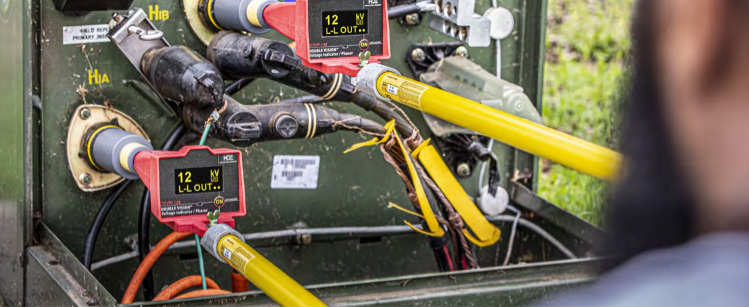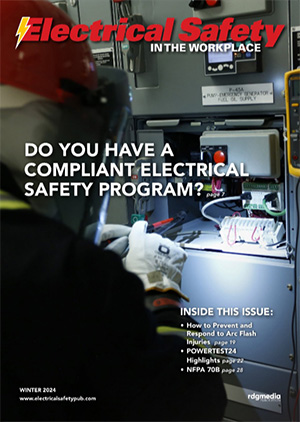Before You Get Started: Things to Consider in High Voltage Work
By Brian Kester, Contributor
Testing, measuring, and controlling electric power with precision and efficiency is an essential part of the work of every power utility and electrical professional. There are a variety of considerations that utility and electrical professionals must consider regarding safety around high voltage and using test meters. These include following OSHA and employer rules, becoming familiar with the site where work will be performed, tool selection, and understanding the instruction manual. One such related rule you may encounter when working to measure electricity, especially high voltage, is what is known by electricians as the three-step verification process.
After selecting the best meter for the project, the operator should confirm the meter is working correctly by using the industry recognized three-step process of verifying, testing, and reverifying. These steps are:
- First test the meter on a known live circuit or approved testing device to confirm the tool is working properly.
- Next, use the meter to verify the circuit that is being worked on or repaired.
- Third, re-test the meter on a known live circuit or approved testing device, to confirm the meter is still working properly.
A three-step process of verifying, testing, and reverifying will go a long way in ensuring a safe work environment. Taking time at the start of every job to go through the process will ensure work is completed successfully and with improved safety measures.
As you think about applying the three-step process, here are some related things to consider:
- Understand lockout/tagout procedures – It is important to not only disconnect all circuits, but also ensure all lockout/tagout procedures are followed to control hazardous energy. Procedures will vary by type of equipment.
- Do not skip a step – It can be tempting to complete only the first two parts of the process thinking that reverification is not necessary when the first two steps have been done properly. However, what if the meter is not working properly and the first reading was inaccurate? The only way to know would be to do a second verification to compare readings.
- Err on the side of caution – If, during the lockout/tagout process, confirmation of shutoff cannot be confirmed, make sure a separator or isolator is used to ensure a safer work area (i.e., rubber blankets, rubber boots).
Along with the three-step process, the type of tools you use on the job site are equally important. A few things to consider as you select a tool are:
- Testing tool type matters – In assessing a job site, choosing the correct testing tool to use is important. Voltage testing tools come in three categories – non-contact, sensing, and contact –the optimal tool for measurement will vary depending on the application. Some general examples:
- Non-contact tool – This type of testing tool is used to learn more about an electrical field, but without discovering voltage or a true reading. For example, non-contact tools can be attached to a hot stick for utility line repairs, or a non-contact personal voltage detector worn on the outside of clothing or other protective gear can be used by first responders and storm restoration crews to alert them to hidden live wires. Here, just knowing electricity is present is helpful to the worker.
- Sensing/Indication – This type of testing tool is used to ascertain a general idea of voltage in the area. For example, utility workers in bucket trucks will attach this type of tool to a fiberglass hot stick and contact the power line to help identify if voltage is present without requiring an extremely accurate voltage reading.
- Contact – This type of testing tool is used when a more accurate voltage reading is required. For example, in industrial settings where three-phase electrical systems are regularly used, a contact testing tool can help provide a more accurate reading of voltage in each phase.
- Add additional protection – In addition to the basic testing tools and equipment, depending on the type of job site you most frequent, other tools and gear can add an extra level of protection. For example, is there a new advanced type of glove that would be beneficial? Or tools that can test ancillary equipment for dielectric strength? Always be sure to follow industry, OSHA, and company work practices and safety procedures.
- Take time for tool maintenance – Regardless of the tools being used, a regular review of tools for any needed maintenance is essential. It is important to look for wear and tear and follow maintenance requirements to keep testing tools and other equipment in top shape.
Taking some time to select the best tools, following proper procedures on the job site, and keeping up with maintenance are simple steps that will go a long way in ensuring safety in high voltage work. ESW
Brian Kester is a professional tool specialist at Greenlee, a leading manufacturer of high-quality tools for electrical and utility trade professionals (greenlee.com).
Share on Socials!
Workplace Electrical Injuries and Fatalities 2003-2020
Electrical Safety Finds Its North Star
Arc Flash Analysis: A Project Overview for Electrical Contractors
Leaders in Electrical Safety
• Aramark
• Bowtie Engineering
• Enespro
• Ericson
• I-Gard Corporation
• IRISS
• KERMEL, INC.
• Lakeland Industries
• MELTRIC Corporation
• National Safety Apparel
• National Technology Transfer
• Oberon
• Saf-T-Gard
• SEAM Group
Subscribe!
Sign up to receive our industry publications for FREE!








